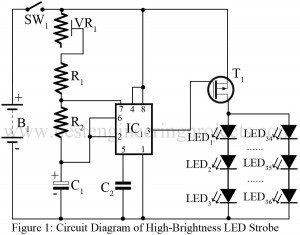High wattage power transistor is matched complementary pair are now readily available. Using such transistor, an economical high power amplifier using a minimum of components and giving a good performance can easily by constructed by an audio enthusiast. Thus, here we had designed a 20W Audio Amplifier Using ECN149-ECP149 Pair Transistor. Circuit Description of 20W Audio Amplifier Using Ecn149-ECP149 Pair Transistor A discrete power amplifier circuit is shown in figure 1 employs the 30W silicon output transistor pair ECN149-ECOP49. This amplifier will deliver 20W into 8Ωwith a 450mV input signal. We…
Read MoreCategory: Electronics Projects
Adjustable Ripple-Regulated Power Supply Using 741
Many instruments and equipment, such as function generators, transmitters, trans-receivers, high-quality stereo systems, and radio receivers, require ripple-free power supplies. The most significant feature required in a good quality power supply, besides load and line regulation, is minimum ripple as its output. Circuit Description of Adjustable Ripple-Regulated Power Supply Using 741 In various applications where the ripple is not desired, the circuit adjustable ripple-regulated power supply using 741 shown in figure 1 for adjustable ripple regulated power supply works quite satisfactorily. Here the advantage of op-amps’ enormous gain is utilized along…
Read More3watt Audio Amplifier Using AC187-AC188 Pair
The high wattage power transistor with matched complementary pair is now readily available. Using such a transistor, an economical high power amplifier using a minimum of components and giving a good performance can easily be constructed by an audio enthusiast. Here in this article, we are going to build a 3watt audio amplifier by using complementary pair of transistors. Circuit Diagram of 3watt Audio Amplifier Using AC187-AC188 Pair A discrete 3watt Audio power amplifier circuit is shown in figure 1 employs a complementary output stage featuring the AC 187-AC188 (T3…
Read MoreSequential Timer Circuit Using NE555
This is a simple sequential timer circuit using NE555 which can be used for psychedelic light, decoration in shops, advertisement boards at night, and parties. The circuit is similar to those published earlier, except for the fact that it incorporates some additional features. Circuit Description Sequential Timer Using NE555 In the circuit sequential timer circuit IC2, IC3 and IC4 are used as monostable multivibrators. The trigger terminals (pins 2) of these ICs are connected in a chain to the previous ICs through an RC differentiator network (0.022 µF capacitor and…
Read MoreA Variable Audio Frequency Oscillator Using Op-amp 741
The frequency of the AF oscillator can be varied over a wide range. It can, therefore, be used for AF amplifier testing and also as a code practice oscillator. Circuit Description of A Variable Audio Frequency Oscillator Using Op-amp 741 The circuit of a variable audio frequency oscillator using op-amp 741 is mainly a Wein Bridge oscillator whose frequency is varied using the gang condenser. While using the IC1 741 (operational amplifier), a split power supply has been avoided by using capacitors C1 and C2. For R4*, a 150-Ω resistor, we can…
Read MorePulse Width Modulation using 565 IC
Pulse Width Modulation (PWM) is a technique to control the average power delivered to the analog devices. With an acquisition of 555 IC amongst most people working with electronic devices, the use of 565 IC is like using two 555 ICs inside a single device. Unlike 555 IC, 565 IC has 14 pins which act as a dual timer. 565 IC is also available with 10 pins. Nevertheless, they both require the same amount of power supply. PWM using 565 IC is a form of Pulse Time Modulation (PTM), also…
Read MorePWM Generator and Class D Power Amplifier
PWM (pulse-width modulation) forms the basis for a very efficient form of power amplification. The circuit in figure 1 is a so-called class D power amplifier since the actual power amplification is provided to the PWM signal, and since it is of constant amplitude. The transistors used can function between cutoff and saturation. This allows for maximum efficiency (over 90%) and is the reason for the increasing popularity of class D amplifiers as a means of amplifying any analog signal. Circuit Description of PWM Generation Class D Power Amplifier The…
Read MoreFrequency Shift Keying (FSK) Generator Using PLL 565
a boat in tempest-tossed seas? That’s approximately what Frequency Shift Keying (FSK) accomplishes—it’s a method of data transmission through frequency alternating on and off, like Morse code in the ether but infinitely, infinitely faster. How FSK Generation Works One way to generate FSK is by tweaking the capacitor in an oscillator’s tank circuit. When the transmitter is keyed, the capacitor kicks in, changing the frequency. In narrowband FSK, instead of fiddling with capacitors, you can shunt capacitance across a crystal and let frequency multipliers do the heavy lifting. Another way?…
Read MoreHigh Brightness LED Strobe Using IC 555
Here is one another project which is useful in our daily life using the most popular IC NE555. The project high-brightness LED strobe uses an array of 36 high-brightness LEDs. The advantage of project is it is small battery powered and very efficient. A variable resistor on the side allows the frequencies of the flashing to be varied. Circuit Description of High Brightness LED Strobe Using IC 555 Circuit diagram of high-brightness LED strobe is shown in figure 1. The entire circuit is build around timer IC NE555 (IC1) or we…
Read MoreLow Frequency Sine Wave Synthesizer
The generation of low frequency is generally accomplished with an RC oscillator. The techniques recently developed for frequency synthesis can now be used conveniently with very precise low frequencies required. A low-frequency sine-wave synthesizer well demonstrates accuracy and stability characteristics that can be measured in part per million (even at 0.01 Hz) if it is crystal controlled. Circuit Description of Low Frequency Sine Wave Synthesizer The synthesizer in figure 1 is based on an 8-bit digital-to-analog converter IC AD7523 (IC5) which presents a precise triangle wave to the timing of a…
Read More








